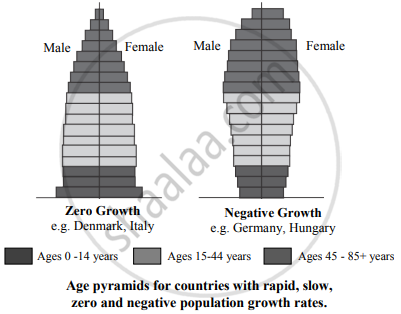Advertisements
Advertisements
प्रश्न
Define population growth. Explain different types of age pyramids.
उत्तर
Definition: The increase in the size of a population or increase in number of individuals is known as population growth. When resources in the habitat are unlimited, population show exponential growth. When resources in the habitat are limited, it leads to competition between individuals for limited resources. This type of population growth is called logistic growth
Age distribution and Age pyramids:
- A population consists of individuals with different ages. The entire population is divided into three age groups - prereproductive (0-14 years), reproductive (age 15-44 years), post reproductive (45-85+years)The relative proportion of individuals of various age groups in the population is referred to as age structure of the population.
- If the age distribution (per cent individuals of a given age or age group) is plotted for the population, the resulting structure is called as age pyramid.


संबंधित प्रश्न
The number of deaths under ideal conditions is known as ______.
What is Commensalism? Explain it with suitable example.
Tabulate and analysis of two species population interaction.
Identify the interspecific interaction depicted in the following figure.

Mycorrhizae are the example of ______.
What is mycorrhiza?
In an association of two animal species, one is a termite which feeds on wood and the other is a protozoan Trichonympha present in the gut of the termite. What type of association they establish?
Fill in the blanks
| Species A | Species B | Type of Interaction | Example |
| + | - | ______ | ______ |
| + | + | ______ | ______ |
| + | 0 | Commensalism | ______ |
In an aquarium two herbivorous species of fish are living together and feeding on phytoplanktons. As per the Gause’s Principle, one of the species is to be eliminated in due course of time, but both are surviving well in the aquarium. Give possible reasons.
What happens to an inferior competitor if a superior competitor is present in the same environment?
